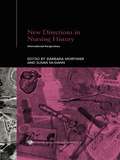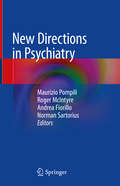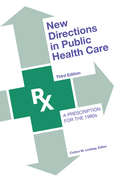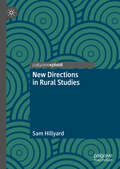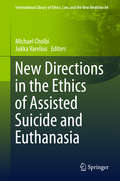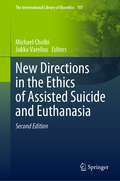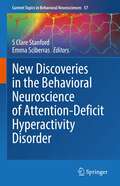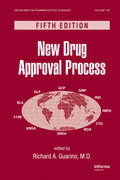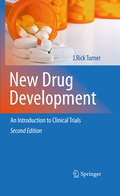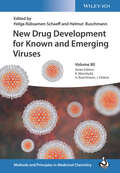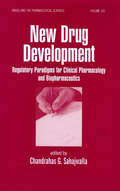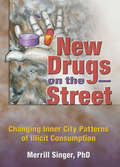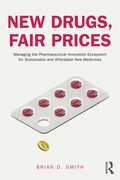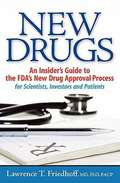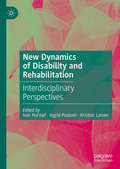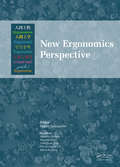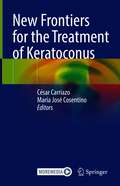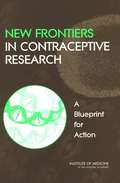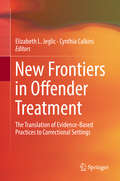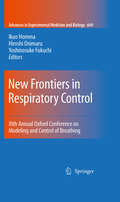- Table View
- List View
New Directions in Nursing History: International Perspectives (Routledge Studies in the Social History of Medicine #Vol. 22)
by Barbara Mortimer Susan McGannThis collection of essays reflects the current interdisciplinary and international nature of the history of nursing scholarship. Covering a range from the eighteenth to the twentieth century, this book draws on research from eleven different countries to address: the issues of professionalism within nursing the social and ethical issues which are woven into the relationship between the nurse/midwife and her patient/client the trans-cultural dimensions nurses create when they move from one culture to another and the recent developments in historiography.
New Directions in Psychiatry
by Norman Sartorius Andrea Fiorillo Maurizio Pompili Roger McIntyreThis book focuses on hot issues faced by clinicians in everyday clinical practice, and provides in-depth analyses of both met and unmet needs in the management of psychiatric disorders. It has been repeatedly shown that the needs of patients, relatives, the community at large and those of the governmental bodies only partially overlap. For instance, patients in their families are more concerned about quality of life, treatment, autonomy, and independent living; whereas governmental stakeholders are typically more concerned about relapse prevention and reduction of hospitalizations. As such, a volume bridging the gap between theoretical notions and practical understanding of patients’ untreated aspects of their psychiatric disorders is much needed. Instead of focusing on traditional descriptions of psychopathology and diagnostic criteria, the volume guides readers to core problems for each topic, taking into account new approaches in the classification of mental disorders as proposed by DSM-5. It elaborates on much-debated controversial problems such as the assessment and treatment of psychomotor agitation, and non-adherence to treatment that impacts on the psychiatric context. With its unique approach, this volume appeals to anyone with an interest in the field, including researchers, clinicians, and trainees.
New Directions in Psycho-Analysis: The significance of infant conflict in the pattern of adult behaviour
by Melanie Klein Paula Heimann R E Money-KyrleTavistock Press was established as a co-operative venture between the Tavistock Institute and Routledge & Kegan Paul (RKP) in the 1950s to produce a series of major contributions across the social sciences. This volume is part of a 2001 reissue of a selection of those important works which have since gone out of print, or are difficult to locate. Published by Routledge, 112 volumes in total are being brought together under the name The International Behavioural and Social Sciences Library: Classics from the Tavistock Press. Reproduced here in facsimile, this volume was originally published in 1955 and is available individually. The collection is also available in a number of themed mini-sets of between 5 and 13 volumes, or as a complete collection.
New Directions in Public Health Care: A Prescription for the 1980's
by Cotton M. LindsayThis volume is a revised edition of The Institute for Contemporary Study's report on national health insurance. It includes an analysis of legislation currently before Congress; an examination of hos-pital cost increases and cost containment; an in-vestigation of the politics of the National Health Insurance which asks if any major interest group involved in health care wants increased competi-tion; new research on both the NHS in Britain and Canada's relatively recent experiments with full NHI; an update on public health care; a considera-tion of the relationship between health and health care; a discussion of the subsidy of health care; and an analysis of the market for medical care and the effects of an NHI on the market for physicians.
New Directions in Rural Studies
by Sam HillyardUsing theory and method, this book seeks to critique and illuminate rural matters. Rural issues are tenacious and contested, as we continue to value the green and pleasant land, but in a rose-tinted way. The opening chapter provides a contextualising discussion of the new ways rurality has been conceptualised. Critical debates by leading scholars in recent years have expressed concern about the direction of travel inside rural areas and also with associated academic disciplines. These are overviewed and evaluated, as are the general trends in rural scholarship. This chapter then frames subsequent chapters on substantive areas of rural studies – both benign and contested. The subsequent chapters unpack specific issues through original case studies, illuminating the contemporary rural. They are the green wellbeing zeitgeist, narrowed to focus upon gardening, and at the other extreme the more emotive issue of country sports and live quarry game shooting. A third and final substantive chapter offers new empirical evidence of a rural coastal community experiencing acute healthcare needs. Offering original case studies that illuminate and inform new theoretical ideas around the rural, this book is essential reading for academics and students across disciplines interested in rural matters.
New Directions in Third Wave Human-Computer Interaction: Volume 1 - Technologies (Human–Computer Interaction Series)
by Michael Filimowicz Veronika TzankovaAs the first extensive exploration of contemporary third wave HCI, this handbook covers key developments at the leading edge of human-computer interactions. Now in its second decade as a major current of HCI research, the third wave integrates insights from the humanities and social sciences to emphasize human dimensions beyond workplace efficiency or cognitive capacities. The earliest HCI work was strongly based on the concept of human-machine coupling, which expanded to workplace collaboration as computers came into mainstream professional use. Today HCI can connect to almost any human experience because there are new applications for every aspect of daily life. Volume 1 - Technologies covers technical application areas related to artificial intelligence, metacreation, machine learning, perceptual computing, 3D printing, critical making, physical computing, the internet of things, accessibility, sonification, natural language processing, multimodal display, and virtual reality.
New Directions in the Ethics of Assisted Suicide and Euthanasia
by Michael Cholbi Jukka VareliusThis book provides novel perspectives on the ethical justifiability of assisted dying. Seeking to go beyond traditional debates on topics such as the value of human life and questions surrounding intention and causation, this volume promises to shift the terrain of the ethical debates about assisted dying. It reconsiders the role of patient autonomy and paternalistic reasons as well as the part proposed for medical professionals and clinical ethics consultation in connection with assisted dying, relates the debate on assisted dying to questions about organ-donation and developments in medical technology, and demonstrates the significance of experimental philosophy in assessing questions of assisted dying. This book is ideal for advanced courses in bioethics and health care ethics.
New Directions in the Ethics of Assisted Suicide and Euthanasia (The International Library of Bioethics #103)
by Michael Cholbi Jukka VareliusThis book provides novel perspectives on ethical justifiability of assisted dying in the revised edition of New Directions in the Ethics of Assisted Suicide and Euthanasia. Going significantly beyond traditional debates about the value of human life, the ethical significance of individual autonomy, the compatibility of assisted dying with the ethical obligations of medical professionals, and questions surrounding intention and causation, this book promises to shift the terrain of the ethical debates about assisted dying. The novel themes discussed in the revised edition include the role of markets, disability, gender, artificial intelligence, medical futility, race, and transhumanism. Ideal for advanced courses in bioethics and healthcare ethics, the book illustrates how social and technological developments will shape debates about assisted dying in the years to come.
New Discoveries in the Behavioral Neuroscience of Attention-Deficit Hyperactivity Disorder (Current Topics in Behavioral Neurosciences #57)
by Emma Sciberras S Clare StanfordNew Discoveries in the Behavioral Neuroscience of Attention Deficit Hyperactivity Disorder reviews the latest developments in preclinical and clinical research of Attention Deficit Hyperactivity Disorder. As well as updating key chapters that were included in an earlier edition, this volume includes some new topics that are attracting a great deal of interest and point the way to new and promising directions for future research. The chapters follow five main themes: Current perspectives on the clinical profile of ADHD and its treatment, common co-occurring conditions, neurobiological studies examining brain function and genetics, animal and in vitro studies, and future directions. This combination of topics emphasises the translational relevance and validity of preclinical research so as to enable a better understanding of ADHD and to highlight the promising strategies for developing new treatments.
New Drug Approval Process (Drugs and the Pharmaceutical Sciences)
by Richard A. GuarinoThe thoroughly revised Fifth Edition of New Drug Approval Process supplies readers with the latest global changes that affect pharmaceutical product approval and influence how new products are researched and marketed.Updated chapters include:advances in international regulatory requirements, including ICH guidelines and harmonizationa step-by-step
New Drug Development
by J. Rick TurnerNew Drug Development: Second Edition provides an overview of the design concepts and statistical practices involved in therapeutic drug development. This wide spectrum of activities begins with identifying a potentially useful drug candidate that can perhaps be used in the treatment or prevention of a condition of clinical concern, and ends with marketing approval being granted by one or more regulatory agencies. In between, it includes drug molecule optimization, nonclinical and clinical evaluations of the drug's safety and efficacy profiles, and manufacturing considerations. The more inclusive term lifecycle drug development can be used to encompass the postmarketing surveillance that is conducted all the time that a drug is on the market and being prescribed to patients with the relevant clinical condition. Information gathered during this time can be used to modify the drug (for example, dose prescribed, formulation, and mode of administration) in terms of its safety and its effectiveness. The central focus of the first edition of this book is captured by its subtitle, 'Design, Methodology, and Analysis'. Optimum quality study design and experimental research methodology must be employed if the data collected--numerical representations of biological information--are to be of optimum quality. Optimum quality data facilitate optimum quality statistical analysis and interpretation of the results obtained, which in turn permit optimum quality decisions to be made: Rational decision making is predicated on appropriate research questions and optimum quality numerical information. The book took a non-computational approach to statistics, presenting instead a conceptual framework and providing readers with a sound working knowledge of the importance of design, methodology, and analysis. Not everyone needs to be an expert in statistical analysis, but it is very helpful for work (or aspire to work) in the pharmaceutical and biologics industries to be aware of the fundamental importance of a sound scientific and clinical approach to the planning, conduct, and analysis of clinical trials.
New Drug Development for Known and Emerging Viruses (Methods & Principles in Medicinal Chemistry)
by Raimund Mannhold Jörg HolenzDiscusses how to fight Ebola, SARS Corona, and other known or emerging human viruses by building on the successes in antiviral therapy of the past decades Written by leading medicinal chemists from academia and industry, this book discusses the entire field of antiviral drug discovery and development from a medicinal chemistry perspective, focusing on antiviral drugs, targets, and viral disease mechanisms. It provides an outlook on emerging pathogens such as Ebola, Zika, West Nile, Lassa, and includes a chapter on SARS Coronoavirus-2 causing the present pandemic. New Drug Development for Known and Emerging Viruses describes the discovery and development process for antiviral agents for different classes of viruses and targets based on the experiences from the nine human viruses for which approved drugs are on the market (HIV, HCV, Influenza, RSV, HBV, HPV, HCMV, HSV, and VZV). It covers the properties and potential of 20 classes of currently approved antivirals, including combination drugs, and looks at novel antiviral strategies against emerging viruses. Covers the entire field of antiviral drug discovery and development Addresses the need for antiviral drugs to combat major health threats such as Ebola, Zika, West Nile, and SARS Coronavirus-2 Summarizes the successes of the past 15 years in developing ground-breaking medicines against 9 major human viruses, both from the medicinal chemistry and the pharmacological angle Discusses practical and strategic challenges in the drug discovery and development process, including screening technologies, latency, and toxicity issues New Developments in Antiviral Drugs is an important book for medicinal chemists, pharmaceutical chemists, virologists, and epidemiologists, and will be of great interest to those in the ;pharmaceutical industry and public health agencies.
New Drug Development: Regulatory Paradigms for Clinical Pharmacology and Biopharmaceutics (Drugs and the Pharmaceutical Sciences)
by Chandrahas G. SahajwallaHighlighting key points from the latest regulatory requirements, New Drug Development helps those new to the world of pharmaceutical development understand regulatory steps, reduce cost by avoiding unnecessary trials, and attain guidance through each step of the drug approval process. This volume acquaints readers with procedures that determine the
New Drugs on the Street: Changing Inner City Patterns of Illicit Consumption
by Merrill SingerLearn the public health implications of shifting drug-related risks among the inner city poorInner city drug use behavior shifts and changes, leaving past drug treatment programs, drug prevention efforts, health care provisions for drug users, and social service practice unprepared to effectively respond. New Drugs on the Street: Changing Inner City Patterns of Illicit Consumption tackles this problem by presenting the latest ethnographic and epidemiological studies of emerging and changing drug use behaviors in the inner city. This one-of-a-kind resource provides the latest research to help readers reconceptualize ways to think about today&’s drug use to more effectively address the growing problem.Unless public health and social service professionals keep in step with the shifting patterns of drug behaviors, drug use epidemics will inevitably unfold. New Drugs on the Street reveals the latest drug use practices of the poor in the inner city, with a concentration on the research in African-American and Latino populations. Each chapter gives an in-depth look at the use of various psychotropic drugs most recently gaining popularity, along with the surprising reemergence of PCP. The rampant use of ecstasy in the rave scene is explored, along with the effects of its heavy use, its after-effects, the likelihood of poly-drug mixing, and dangerous sex risk behaviors. Urban youth drug networking is examined in detail. The alarming use of embalming fluid mixtures is discussed, along with the disturbing public health implications of its use. The illicit use of narcotics analgesics (NA) like Vicodin and other pain killers is also explored, including the unclear association between NA use and Hepatitis C. A final chapter presents the latest information on Haitian youth and young adults in Miami, Florida, with ethnographic background to illustrate the reasons for drug use in this and other ethnic minorities. This valuable source is extensively referenced and includes several helpful tables to clarify research data.New Drugs on the Street examines: ecstasy diverted pharmaceutical painkillers PCP embalming fluid narcotics analgesics (NA) drug use dynamics the changing street drug scene new drug combinations new drug-involved populationsNew Drugs on the Street reveals the nature and direction of the latest drug use and is essential reading for health professionals in the health social sciences, public health, nursing, and substance abuse fields that deal with low income, ethnic minority, and inner city populations.
New Drugs, Fair Prices: Managing the Pharmaceutical Innovation Ecosystem for Sustainable and Affordable New Medicines
by Brian D. SmithNew Drugs, Fair Prices addresses the important question of how we might get the innovative new medicines we need at prices we can afford. Today, this debate is impassioned but sterile. One side calls for price controls, discounting their impact on investment in innovation. The other points to miraculous new therapies, disregarding their affordability and social inequity. This polarized argument creates more heat than light, threatening the social contract between the industry and society on which pharmaceutical innovation depends. This ground-breaking book takes a wholly new perspective on the issue and raises the debate to a more informed and productive level. Drawing on interviews with more than 70 experts across the pharmaceutical innovation world and combining a diverse literature from scientific, political, economic and business domains, it describes how a sustainable and affordable supply of new medicines is possible only by balancing pharmaceutical innovation’s complex, adaptive ecosystem. By considering how each of the ecosystem’s seven habitats work and interact with the others, it makes a comprehensive set of recommendations for achieving that ecosystem balance. The core message of New Drugs, Fair Prices is important to anyone who ever has needed or will ever need a medicine: we can have a sustainable supply of new medicines that are both innovative and affordable if we manage the pharmaceutical innovation ecosystem intelligently.
New Drugs: An insider's Guide to the FDA's New Drug Approval Process for Scientists, Investors and Patients
by Lawrence T. FriedhoffDrug development, the processes by which a chemical compound becomes a “drug” and is approved for sale by the FDA and European and Asian regulators, is not for the faint-of-heart or the shortsighted. Designing and monitoring studies, obtaining and analyzing scientific data, and reconciling clinical results against the ethical constraints and regulatory guidelines of government agencies, requires a complex interaction of in-house specialists and academic and commercial consultants worldwide. Scientific, technical, and tactical considerations play out in an environment where a balance must be struck between the often-competing interests of the corporation, its investors, government regulators, and the safety and well being of intended patients. All the while, dwindling patent protections impose an ever-contracting timeframe for success. Written to be accessible to a wide audience, NEW DRUGS provides a thorough, succinct, and practical understanding of these drug-development processes. If you’re involved in the pharmaceutical industry, NEW DRUGS will provide scientific and management tools to increase the likelihood of regulatory approval at each phase of your compound’s development. If you’re a patient or consumer, NEW DRUGS will enable you to intelligently discuss medications with your health-care provider and empower you to make informed decisions at the pharmacy. If your portfolio, rather than your health, makes you an interested observer of the fortunes of this critical sector of the US economy, NEW DRUGS will help you to decode press releases and annual reports, so that you can recognize and invest in well-run companies with promising products.
New Dynamics of Disability and Rehabilitation: Interdisciplinary Perspectives
by Ivan Harsløf Ingrid Poulsen Kristian LarsenThis collection provides a broad coverage of recent changes in medical and vocational rehabilitation in Northern Europe. It presents analyses that cut across health sciences, medical sociology, disability studies and comparative welfare state research. Through this interdisciplinary perspective, the book explores the changing roles of patients, caregivers, professionals and institutions, and the wider implications of these changes for social inequalities in health. What obstacles do different groups of patients encounter when negotiating the complex chains of medical and vocational services? Who decides regarding references to specialized treatments, and the provision of comprehensive and coordinated services, and different types of benefits and material support? What is the importance of the resources that patients and caregivers bring to bear in the rehabilitation process?
New Ergonomics Perspective: Selected papers of the 10th Pan-Pacific Conference on Ergonomics, Tokyo, Japan, 25-28 August 2014
by Sakae YamamotoNew Ergonomics Perspective represents a selection of the papers presented at the 10th Pan-Pacifi c Conference on Ergonomics (PPCOE), held in Tokyo, Japan, August 25-28, 2014.The first Pan-Pacific Conference on Occupational Ergonomics was held in 1990 at the University of Occupational and Environmental Health, Japan. The main theme of the PPCOE 1990
New Feminist Stories of Child Sexual Abuse: Sexual Scripts and Dangerous Dialogue
by Sam Warner Paula ReaveyThe international feminist contributors to this book look through the lens of poststructuralism at how child sexual abuse is differently represented and understood in the populist, academic, clinical, media and legal contexts. Reworking earlier feminist analyses, they show how child sexual abuse is not just about gender and power but also about class, race and sexuality. The first, theoretical section of the book critiques normative theories of the 'effects' of abuse, explores the impact and consequences of feminist interventions and critically examines the potential usefulness of a feminist post-stucturalist approach. In the second part, these understandings are applied to specific arenas of practice with the aim of providing a framework for critical intervention and alternative and better ways of working with child sexual abuse.
New Forms of Urban Agriculture: An Urban Ecology Perspective
by Harpreet Kaur Jessica Ann DiehlEating locally and developing an urban-rural food continuum is a rapidly evolving movement. Integration of multi-functional forms of agriculture — termed New Forms of Urban Agriculture (NFUA) — could be a critical adaptation to strengthen this movement and for the sustainability of cities. While NFUA have the potential to provide diverse benefits to humans, there is an absence of reliable empirical data on the scale and impact of urban resources on NFUA which has a profound impact on its viability and sustainability. In this book, we shift the focus from how NFUA have potential to impact the urban system to investigate the potential impacts of urban resources on NFUA. Access to resources such as land, labour, clean water, etc. are major barriers to enter the agriculture sector in the cities; the chapters in this book present projects or reviews recent research on the subject from different cities in the world. This edited volume offers critical perspectives from diverse disciplines, expertise, and geographic contexts related to the actual and potential role of urban and peri-urban agriculture in the developing and the developed world where forms, adaptations, and debates around NFUA vary distinctively. Using and urban ecology lens, the book provides empirical evidence of how urban resources of land, water/waste, labour, and biodiversity impact NFUA.
New Frontiers for the Treatment of Keratoconus
by César Carriazo María José CosentinoThis book updates the reader about the latest bio-mechanical concepts underlying keratoconus diagnosis and the various treatment alternatives: from conventional alternatives with a real cost/benefit description, to some innovative alternatives that have come to the fore in recent years. It discusses the latest software and technology utilized in keratoconus diagnosis as well as the more innovative surgical techniques used to treat keratoconus.New Frontiers for the Treatment of Keratoconus represents an essential book for ophthalmologists and specialists in cornea and refractive surgery who are looking to position themselves at the forefront of the diagnosis and treatment of keratoconus.
New Frontiers in Contraceptive Research: A Blueprint for Action
by National Research CouncilMore than a quarter of pregnancies worldwide are unintended. Between 1995 and 2000, nearly 700,000 women died and many more experienced illness, injury, and disability as a result of unintended pregnancy. Children born from unplanned conception are at greater risk of low birth weight, of being abused, and of not receiving sufficient resources for healthy development. A wider range of contraceptive options is needed to address the changing needs of the populations of the world across the reproductive life cycle, but this unmet need has not been a major priority of the research community and pharmaceutical industry. New Frontiers in Contraceptive Research: A Blueprint for Action, a new report from the Institute of Medicine of the National Academies, identifies priority areas for research to develop new contraceptives. The report highlights new technologies and approaches to biomedical research, including genomics and proteomics, which hold particular promise for developing new products. It also identifies impediments to drug development that must be addressed. Research sponsors, both public and private, will find topics of interest among the recommendations, which are diverse but interconnected and important for improving the range of contraceptive products, their efficacy, and their acceptability.
New Frontiers in Environmental Toxicology
by Tanu JindalThis volume provides up-to-date information on toxic pollutants in the environment and their harmful effects on human health and nature. The book covers many important aspects of environmental toxicology, such as features, characterization, applications, environmental routes for dispersion, nanotoxicity, ecotoxicity and genotoxicity of nanomaterials, with emphasis on radiation toxicology, polar ecotoxicology, plastic toxicology, microbrial toxicology, nanotoxicology and pesticide toxicology. Also discussed is the use of microbes and nanotechnology for medicinal purposes, which has revealed important chemical prototypes in the discovery of new agents, stimulating the use of refined physical techniques and new syntheses of molecules with pharmaceutical applications for human welfare. The chapters also address the fate of nanoparticles in the environment, as well as nanotoxicology mechanisms impacting human health. The book will be of interest to toxicologists, environmental scientists, chemists, and students of microbiology, nanotechnology and pharmacology.
New Frontiers in Offender Treatment: The Translation of Evidence-Based Practices to Correctional Settings
by Elizabeth L. Jeglic Cynthia CalkinsThis book reviews how new and promising evidence-based interventions are being used with those involved in the criminal justice system. While there has been an increased emphasis on evidence-based practice within forensic treatment, there remains a disjoint between what we know works and adapting these interventions to those involved in the criminal justice system. This book seeks to bridge that gap by providing an overview of what we know works and how that information has been translated into offender treatment. In addition, it highlights avenues where additional research is needed. This book is comprised of three parts:In the first part, current models of correctional treatment including the Risk, Needs, Responsivity Model, The Good Lives Model and Cognitive Behavioral Models are presented. In the second part, the chapters address clinical issues such as the therapeutic alliance, clinician factors, and diversity related issues that impact treatment outcome. In the third and final part of the book, adaptions of innovative and cutting-edge evidence-based treatments such as Dialectical Behavior Therapy, Trauma Informed Care, Mindfulness, Motivational Interviewing, Assertive Community Treatment, Multisystemic Treatment, New frontiers in Intimate Partner Violence treatment, and the current research on the treatment of those with psychopathy are presented. Research supporting these treatment approaches targeting areas such as self-management, psychological well-being, treatment engagement and retention and their relationship to recidivism will be reviewed, while their adaptation for use with forensic populations is discussed. The book concludes with the editors’ summary of the findings and a discussion of the future of evidence-based interventions within the field of forensic psychology.
New Frontiers in Respiratory Control
by Hiroshi Onimaru Ikuo Homma Yoshinosuke FukuchiThe Oxford Conference has been first held at Oxford University in 1948. Since then, it has been held every three years in various countries to exchange ideas and learn the latest findings on the control of respiration. The XIth Oxford Conference will focus on respiratory control, especially on the topics of respiratory rhythm generation and chemoreception. Clinical research on sleep apnea syndrome will also be an important subject at the meeting.
